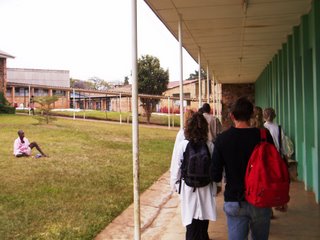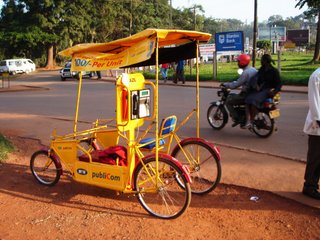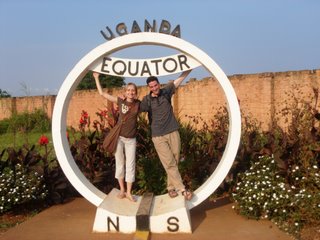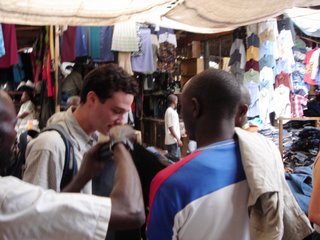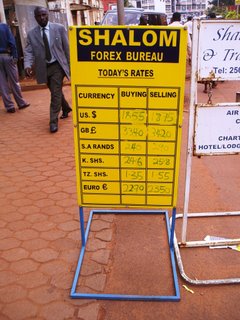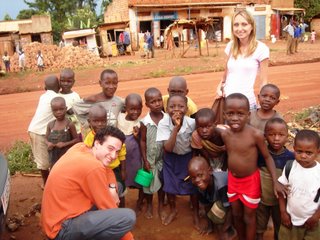Bits and Pieces
Over the past few weeks, I’ve traveled from Santa Cruz to Cuzco, passing through small towns, large cities, Lake Titicaca, the Bolivian-Peruvian border, Machu Picchu, and points in between. Below are a few anecdotes from my travels that I think illustrate some of the more interesting aspects of life here.
El Duende
As the sun set in Santa Cruz, it had begun to rain. Tropical location aside, Bolivia’s elevation means that the July winter in Santa Cruz can be cold. Alex, Cindy, and I had rushed to nestle under a small overhang, avoiding the spray while crossing our arms to ward off the cold. Cindy was keeping their daughter Aisha close by. Alex would later tell me that this was the first time in his three years in Santa Cruz that he could remember seeing his own breath.
“Do you see that hitching post across the street?” Cindy motioned to me as we waited for the micro-bus to arrive. I glanced to the opposite corner where a small lone wooden post stood fixed into the modern street tiles. There was what looked like a head carved into the top of it. Together, she and Alex told me the story of a young man, a hundred years ago, who having been denied permission to marry his beloved, stood nightly across the street from her window. There he carved her face into that same hitching post, as he watched her and wasted away from grief. They say his ghost still haunts the area.
“Are there many stories like that around here?” I asked.
“Oh sure,” Alex replied, “But here, they’re not stories. These things happen.”
“Bad husbands, adulterers and drunks,” he continued, “They see the black widow when they’re alone. Often it’s in a church. She comes dressed all in black, covered from head to foot, with a veil over her face. She’ll appear, approaching them silently, staring accusingly. They can’t see her eyes, but they know. Sometimes they try to lift her veil to see her face. Maybe they see a skull. Maybe they don’t. Every single one passes out and wakes up alone and frightened.”
“And this actually happens?” I responded incredulously.
“To people I’ve known,” Cindy answered matter-of-factly, “Of course it’s more so in the rural areas, and there it’s mostly el duende.”
“’El duende?’ I don’t know the word. What is it, some kind of Chupacabra?” I asked, referring to the Mexican legend of a short creature with a spiky back that mutilates cattle, sucking their blood until they die.
“Not really, no, though it is a short little creature, about three feet tall. El duende wears a long white robe made of roughly woven indigenous cloth with a hat so ridiculously wide-brimmed you can’t see his face. His hair is long and snow white. He loves beautiful and pure things. That’s why he steals little girls with blonde hair and blue eyes. Only children can see him. In the rural areas, when several children all share the same imaginary friend, speaking to the air and listening as though they hear a response, the parents take notice.”
“Especially the ones whose children have blonde hair and blue eyes?” I quipped.
Cindy looked at me directly, got the joke, smiled a little, but wasn’t biting.
“It’s very uncommon for rural children to have blonde hair or blue eyes but not unknown. When a little girl disappears, the parents immediately begin searching the woods. If they’re lucky, they find her, alone, crying, on a perfectly clean mat, surrounded by the finest fruits and flowers of the forest.”
“El duende loves only the purest things. It won’t keep a girl once she cries too much or wets herself.”
I was hooked. I was even starting to believe a little bit: “So if it’s only children who can see it, does it ever hurt adults? What about the girls who aren’t found?”
“It depends. Some women are actually married to el duende,” Cindy replied.
“What?!?! Married to el duende? How does that even work?”
“In the smaller towns. These are women who live in large villas on the edge of town. Usually they’re widows or escapees from violent marriages. No one ever sees them work but somehow they always have more than enough money to live. They’ll walk through the village streets holding conversations with empty air. If anyone asks, they’ll say that they’re talking to their husband.”
“Sometimes violent former husbands who have been forced by popular opinion or the law to leave their wives will try to return home to regain them. When they do, an argument usually ensues. The next morning, the woman will wake up, covered from head to toe in bruises. With his history and the sound of the argument to condemn him, rather than face prison time, he usually flees town.”
“El duende keeps his brides.”
Help Control the Pet Population?
Bolivia and Peru are places full of hospitable people, large four-course lunches, and stray dogs that are cute until the moment their barking, car-chasing, and fornication begins to irritate. They represent every breed imaginable, with adorable bright wide eyes and lolling tongues. Some are well kept. Some are fed occasionally by quasi-owners who otherwise leave them alone to roam the streets. The rest bother with humans only to eat their trash, bark at them, or chase their cars in a way that defies their apparently missing sense of self-preservation. Sometimes the dogs form packs. Together they chase females and yowl into the night. With all the barking, I expect Alex could count on his fingers the number of full nights he’s slept since moving to Santa Cruz.
Feral though they are, it’s still hard to find these creatures intimidating. This is probably because they seem so pitiable when the copulating’s done.
For as long as his erection remains, the male is trapped by the female. There’s something a little ridiculous about the sight. Unable to withdraw, he tries desperately to extricate himself. He flips around, facing the opposite direction. There both dogs remain for minutes at a time, bum touching bum, the female patiently exasperated, the male pawing the ground uselessly in occasional furious attempts at escape.
Alex tells me this extra time helps ensure that the first dog is the most likely to impregnate.
The rest of the pack sits back, barking, yapping, and occasionally fighting over who goes next. When the first male finally gets away, the female makes a mad dash for freedom. The rest of the pack chases behind with the winner of the last round of fights in the lead. The former leader usually stays behind, dazed and trying to recover his composure.
The Flota Infomercial
Inter-city buses here are called flotas. They work a little differently then back home. In order to ensure a full complement of passengers, they can be flagged down along the road at any time. The seeming hitchhikers who board pay a fraction of the fare and sit in whatever space is available, including the floor of the aisle. I’ve been forced there myself on occasion. It’s not as comfortable as you’d think.
Other times, passengers ask to be let off early. This has led to an interesting phenomenon:
“Yes, the ultimate information book! Learn all of these essential words in English, including numbers from one, uno, ten, diez, one-hundred, ciento, to even one million, un millión! Also parts of the body, the arm, the foot, the face! There are also basic instructions for important software, Microsoft Word, PowerPoint, Windows, and more! And all of this for only seven Bolivianos!”
I had just started to drift off into sleep, when from the corner of my eye, I saw the man in the second row, seated directly in front of me, begin to stand. “Why did I sit so near the front where the shouting would be?” I asked myself. Inwardly, I began to groan, preparing for the oncoming onslaught.
“Today, as a special offer only we are also presenting this other book, the complete geography and history of Bolivia! Yes, with this book your children can learn the history, location, capital, and major industries of every province! It also contains relevant biographical information about major government figures, including every minister and the president!”
Every sentence ended with an exclamation mark. Not since the first episode of Amazing Discoveries aired in the early nineties had I seen anyone so excited about a new product. I tried to tune him out, despite a slightly unexpected nagging interest in the second book, politely refused the not-to-be-missed opportunity to flip through a sample copy, prepared myself for the final onslaught:
“And for all this, how much would you expect to pay? Today only we are making the special offer of one book for seven Bolivianos! That’s right, either book for only seven Bolivianos! Or, if you act right now, you can have both for just ten! That’s right! One for seven Bolivianos, or two books, containing all this information, including English vocabulary, software, geography, history, and more, for only 10 Bolivianos!!!”
He kept going for a while, nearly exploding with feigned enthusiasm. A few people bought the books. At about $1.25 for both, it wasn’t a bad deal. Eventually the salesman called to the driver for a stop. He left the bus, likely hitching his way back along the ten or twenty kilometers he’d just traveled from town.
With the salesman gone, I reflected to myself that this was better than the last time. On a bus of less than twenty people, that man had spent nearly half-an-hour shouting about the wonders of his new cures for both impotence and prostatitis.
Teacher’s Strike
Having crossed the Peruvian border the previous evening, my tour group had just dropped me off near the central square in Puno, a medium sized town on the shores of Lake Titicaca. A large crowd had gathered in the central square, with banners megaphones, and creative home-made t-shirts. A protest was about to start.
I was hungry. I raced ahead of the plaza to find a restaurant. Behind me, the crowd began to approach, filling the street ten abreast until there was standing room only next to the walls on either side. “Así! Así! Así!” they cried, the Spanish equivalent of, “Yeah, that’s right! That’s so right!”
I still couldn’t make out what they were protesting. Pushed to the side, I asked someone nearby. “They’re teachers,” he replied, as if that explained the matter.
As the crowd marched on, a chorus of beautiful female voices, began singing. They had the consistency of a choir on key. The sound was distant and pleasant, growing louder as this new group approached. I listened for the lyrics, hoping to learn more.
“Presidente mentiroso, ahora te jodiste,” sang the melodic chorus.
Literally translated it meant, “Lying president, now you’ve f---ed yourself!”
These were some angry teachers.
I stopped a few and asked them to explain. “The president announced two weeks ago that the national education system will be privatized. He’s a liar, he breaks all of his promises, and if he doesn’t change, we’ll get a new president!”
In the meantime, the other teachers continued to sing: “Si no nos pagara, eso no nos importa. Con sueldo, sin sueldo, la lucha continuará.”
If you don’t pay us, we don’t care. With wages or without, the fight continues!
Usually it’s the students who start revolutions. I felt like it was nice to see the teachers taking up the slack for once. More realistically, I was amazed to see so many citizens concerned so strongly about public education that they took to the streets to voice their support. At my best guess, I was seeing at least three thousand teachers marching. “If only people back home cared as strongly as these people do, things would be better,” I thought to myself.
“Privatisation of education is horrible,” I told them in broken Spanish as I ducked into a restaurant for lunch, “Good luck to you!”
Hundreds more passed by the restaurant window until finally with a last giant effigy of the president, his eyes crossed out with large x’s, the demonstration passed.
Of course there was more to it than that.
For the past few weeks I’d been hearing stories of massive strikes in Peru disrupting transport much as the bloqueos had in Bolivia.
The Peruvian president was a man known for breaking his campaign promises. He’d been elected before and done none of what he’d promised. This time, a few years after leaving office, claiming that he’d learned his lesson and matured as a leader, he had successfully sought re-election.
Once in office, he began pulling the same technique again, pandering to the more powerful blocks in an effort to avoid rocking the boat. Faced with an inconvenient former policy that had created teaching jobs by allowing anyone with a high school education to seek work in education, he’d tried a two-pronged approach to fix the nation's problem of countless teachers of questionable quality.
The first prong, mandatory skills testing for all teachers, with rewards and consequences implemented to enforce quality made some sense. Hoping to cut his own costs and liability though, he’d also suggested a second policy, relocating responsibility for the administration of the educational system to the community level. Communities here are the smallest unit of government administration. They oversee populations of no more than a few thousand. The second prong failed uproariously. By creating hundreds of completely autonomous boards of education, he was in effect creating a de facto privatised educational system.
Thousands of teachers who already feared the new controls now had an excuse to run amok in their students’ name.
Within the first week, as demonstrations gripped the country, disgruntled teachers seized control of the airport in Cuzco, Peru’s tourist centre, and one of its largest cities. No planes landed or left. Other teachers were soon blocking roads, throwing rocks at any cars or buses that tried to pass.
It soon became hard to distinguish between dedicated teachers and self-serving protesters who threw rocks by day and drank themselves silly in bars by night. Public opinion was confused and consternated.
Luckily for me, by the time I arrived in Peru, the demonstrations were beginning to fade. Though I'm unsure what, if any, the final resolution was, this demonstratoin was the only one I've seen in my two weeks here.




